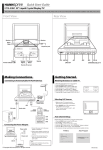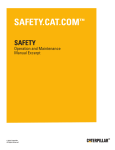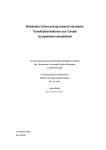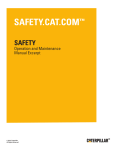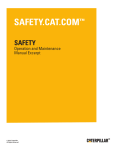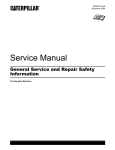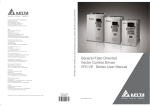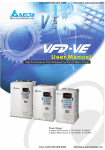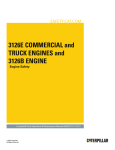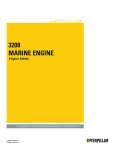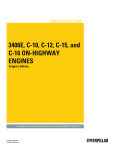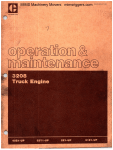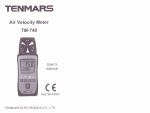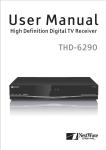Download LT13 and LT18 Landscape Tillers - Safety
Transcript
SAFETY Operation and Maintenance Manual Excerpt © 2010 Caterpillar All Rights Reserved ® ® SEBU7214-01 October 1999 Operation and Maintenance Manual LT13 and LT18 Landscape Tillers AAS1-Up (Work Tool) ABZ1-Up (Work Tool) i01097883 Important Safety Information Most accidents that involve product operation, maintenance and repair are caused by failure to observe basic safety rules or precautions. An accident can often be avoided by recognizing potentially hazardous situations before an accident occurs. A person must be alert to potential hazards. This person should also have the necessary training, skills and tools to perform these functions properly. Improper operation, lubrication, maintenance or repair of this product can be dangerous and could result in injury or death. Do not operate or perform any lubrication, maintenance or repair on this product, until you have read and understood the operation, lubrication, maintenance and repair information. Safety precautions and warnings are provided in this manual and on the product. If these hazard warnings are not heeded, bodily injury or death could occur to you or to other persons. The hazards are identified by the “Safety Alert Symbol” and followed by a “Signal Word” such as “DANGER”, “WARNING” or “CAUTION”. The Safety Alert “WARNING” label is shown below. The meaning of this safety alert symbol is as follows: Attention! Become Alert! Your Safety is Involved. The message that appears under the warning explains the hazard and can be either written or pictorially presented. Operations that may cause product damage are identified by “NOTICE” labels on the product and in this publication. Caterpillar cannot anticipate every possible circumstance that might involve a potential hazard. The warnings in this publication and on the product are, therefore, not all inclusive. If a tool, procedure, work method or operating technique that is not specifically recommended by Caterpillar is used, you must satisfy yourself that it is safe for you and for others. You should also ensure that the product will not be damaged or be made unsafe by the operation, lubrication, maintenance or repair procedures that you choose. The information, specifications, and illustrations in this publication are on the basis of information that was available at the time that the publication was written. The specifications, torques, pressures, measurements, adjustments, illustrations, and other items can change at any time. These changes can affect the service that is given to the product. Obtain the complete and most current information before you start any job. Caterpillar dealers have the most current information available. For a list of the most current publication form numbers available, see the Service Manual Contents Microfiche, REG1139F. When replacement parts are required for this product Caterpillar recommends using Caterpillar replacement parts or parts with equivalent specifications including, but not limited to, physical dimensions, type, strength and material. Failure to heed this warning can lead to premature failures, product damage, personal injury or death. 5 Safety Section Safety Signs and Labels No Step Safety Section i00976484 Safety Signs and Labels SMCS Code: 7405 There are several specific safety signs on this attachment. The exact location of the hazards and the description of the hazards are reviewed in this section. Please become familiarized with all safety signs. Make sure that all of the safety signs are legible. Clean the safety signs or replace the safety signs if you cannot read the words. Replace the illustrations if the illustrations are not legible. When you clean the safety signs, use a cloth, water and soap. Do not use solvent, gasoline, or other harsh chemicals to clean the safety signs. Solvents, gasoline, or harsh chemicals could loosen the adhesive that secures the safety sign. Loose adhesive will allow the safety sign to fall. Replace any safety sign that is damaged, or missing. If a safety sign is attached to a part that is replaced, install a safety sign on the replacement part. Any Caterpillar dealer can provide new safety signs. Illustration 1 g00555650 The label is located on the left on the top side of the mounting bracket for the LT13 Landscape Tiller. g00543929 Do not step here. Stepping here could cause damage to the work tool and personal injury. 6 Safety Section Safety Signs and Labels Operation Illustration 2 Cutting g00555651 This warning label is located on the back of the mounting bracket by the serial number plate. Illustration 3 g00555652 This warning label is located on both sides of the tiller housing. g00543934 Do not operate or work on this machine or work tool unless you have read and understand the instructions and warnings in the Operation and Maintenance Manuals and Owner’s Manuals. Failure to follow the instructions or heed the warnings could result in injury or death. Contact your Caterpillar dealer for replacement manuals. Proper care is your responsibility. g00544005 Stay away from the work tool while it is in operation. Severe injury or death from being cut by the work tool could occur. 7 Safety Section General Hazard Information Flying Objects i00970697 General Hazard Information SMCS Code: 6700 Illustration 4 g00555653 This warning label is located on the front guard. Illustration 5 g00037327 Attach a Special Instruction, SEHS7332, “Do Not Operate” warning tag or a similar warning tag to the mounting bracket before you service the work tool or before you repair the work tool. These warning tags are available from your Caterpillar dealer. Know the maximum operating dimensions of your host machine when the work tool is installed. Know these dimensions in order to maintain proper clearance when you operate near fences or near boundary obstacles. g00544006 Stay clear of this work tool during operation. Flying objects from this work tool could result in injury or death. Wear a hard hat, protective glasses, and other protective equipment, as required. Do not wear loose clothing or jewelry that can snag on controls, on other parts of the machine or on the work tool. Make sure that all protective guards and all covers are secured in place on the machine and on the work tool. Keep the machine free from foreign material. Remove debris, oil, tools, and other items from the deck, from walkways, and from steps. Secure lunch boxes, tools, and other loose items that are not a part of the machine. Know the appropriate work site hand signals and the personnel that are authorized to give the hand signals. Accept hand signals from one person only. Never put maintenance fluids into glass containers. Drain all liquids into a suitable container. Discard any drained fluids and discard any filter elements according to local regulations. 8 Safety Section Crushing Prevention and Cutting Prevention Clean up all spills immediately. i00970912 Use all cleaning solutions with care. Report all necessary repairs. Crushing Prevention and Cutting Prevention Do not allow unauthorized personnel on the machine. SMCS Code: 6700 Unless you are instructed otherwise, perform maintenance under the following conditions: • The host machine is parked on level ground. • The work tool is lowered to the ground and the loader controls for the host machine are in the HOLD position. • The transmission control is in the NEUTRAL position. Support the work tool properly when you perform work beneath the work tool. Do not depend on the hydraulic cylinders in order to support the work tool. A work tool can fall if a control lever is moved or if a hydraulic line breaks. Also, a work tool can fall if a hydraulic cylinder drifts. Unless you are instructed otherwise, never attempt adjustments while the machine is moving or while the engine is running. • The parking brake is engaged. Whenever there are work tool control linkages, the clearance in the linkage area will change with movement of the work tool. • The engine is stopped. Stay clear of all rotating parts and all moving parts. • The engine start switch key is turned off and the When you strike a retainer pin, the retainer pin might fly out. The loose retainer pin can injure personnel. Make sure that there are no people in the area when you strike a retainer pin. To avoid injury to your eyes, wear protective glasses when you strike a retainer pin. engine start switch key is removed. • The battery disconnect switch is in the OFF position and the disconnect switch key is removed. If the host machine is not equipped with a battery disconnect switch, remove the positive battery cable from the battery. Pressure Air Pressure air can cause personal injury. When pressure air is used for cleaning, wear a protective face shield, protective clothing, and protective shoes. The maximum air pressure for cleaning purposes must be below 205 kPa (30 psi). Fluid Penetration Always use a board or cardboard when you check for a leak. Leaking fluid that is under pressure can penetrate body tissue. Fluid penetration can cause serious injury and possible death. A pin hole leak can cause severe injury. If fluid is injected into your skin, you must get treatment immediately. Seek treatment from a doctor that is familiar with this type of injury. Chips or other debris may fly off objects when you strike the objects. Make sure that no one will be injured by flying debris before you strike any object. To avoid injury to your eyes, wear protective glasses when you strike any object. i01145370 Fire Prevention and Explosion Prevention SMCS Code: 6700 If the work tool is equipped with electrical components, clean all electrical connections and tighten all electrical connections. Check the electrical wires daily for loose wires or for frayed wires. Tighten all loose wires before you operate the work tool. Repair all frayed wires before you operate the work tool. All fuels, most lubricants, and some coolant mixtures are flammable. Store all lubricants in properly marked containers and away from all unauthorized persons. Store all oily rags or other flammable material in a protective container. 9 Safety Section Mounting and Dismounting Do not weld pipes that contain flammable fluids or tubes that contain flammable fluids. Do not flame cut pipes that contain flammable fluids or tubes that contain flammable fluids. Clean the pipes or tubes thoroughly with nonflammable solvent before you weld the pipes or tubes or you flame cut the pipes or tubes. Remove all flammable materials (fuel, oil, debris, etc) before the flammable materials accumulate on the work tool. Do not expose the work tool to flames or to material that is burning. Lines, Tubes and Hoses i01138595 Mounting and Dismounting SMCS Code: 6700 • Get on the host machine only at locations that are equipped with steps and/or handholds. Get off the host machine only at locations that are equipped with steps and/or handholds. Utilize the steps that are provided on the work tool when you get on the host machine and when you get off the host machine. • Before you get on the host machine, clean the steps and the handholds. Inspect the steps and the handholds. Make all necessary repairs. Do not bend high pressure lines. Do not strike high pressure lines. Do not install bent lines, bent tubes, or kinked hoses. Do not install damaged lines, damaged tubes, or damaged hoses. Repair loose lines, loose tubes, and loose hoses. Repair damaged lines, damaged tubes, and damaged hoses. Leaks can cause fires. See your Caterpillar dealer for repair or for replacement parts. Check lines, tubes and hoses carefully. Do not use your bare hand to check for leaks. Use a board or cardboard to check for leaks. See Operation and Maintenance Manual, “General Hazard Information” for more details. Tighten all connections to the recommended torque. Replace the parts if any of the following conditions are present: • The end fittings are damaged or leaking. • The outer covering is chafed or cut. • The reinforcing wire layer is exposed. • The outer covering is ballooning locally. • The hose is kinked or crushed. • The armoring is embedded in the outer cover. • The hoses have been pulled or stretched. Make sure that all clamps, guards, and shields are installed correctly. This will help to prevent oil from spraying onto the operator and onto hot engine parts. This will also help to prevent the rubbing of other parts, vibration, and damage while you are operating the work tool. Illustration 6 g00037367 • Face the host machine whenever you get on the host machine and whenever you get off the host machine. • Maintain a three-point contact with the steps and handholds. Note: Three-point contact can be two feet and one hand. Three-point contact can also be one foot and two hands. • Do not get on a moving host machine or on an operating work tool. Do not get off a moving host machine. • Never jump off the host machine or off the work tool. • Do not try to get on the host machine if you are carrying tools or supplies. Do not try to get off the host machine if you are carrying tools or supplies. Use a hand line to pull equipment onto the platform. • Do not use any controls as handholds when you enter the operator’s compartment or when you exit the operator’s compartment. 10 Safety Section Work Tool Operation i01204959 Work Tool Operation SMCS Code: 6700 Only operate the work tool on a host machine that has been approved by Caterpillar. Obey any lift restrictions that are applicable. Refer to Operation and Maintenance Manual, “Caterpillar Approved Machines” for more information. Only operate the work tool while you are in the seat of the host machine. The seat belt must be fastened while you operate the host machine. Only operate the controls while the engine is running. Protective glasses must be worn while you operate the host machine and while you operate the work tool. For maximum service life of the work tool, make a thorough walk-around inspection. Refer to Operation and Maintenance Manual, “Walk-Around Inspection”. After you inspect the work tool and you perform any necessary repairs, you can operate the work tool. While you operate the work tool slowly in an open area, check for proper operation of all controls and all protective devices. Before you move the host machine with the work tool, ensure that no one will be endangered. Note any needed repairs during operation of the work tool. Report any needed repairs. Carry work tools low to the ground. Refer to Operation and Maintenance Manual, “Transport Position”. Do not go close to the edge of a cliff, an excavation, or an overhang. Maintain control of the host machine while you operate the work tool. Do not overload the host machine beyond the capacity of the host machine. Do not overload the work tool beyond the capacity of the work tool. Know the maximum operating dimensions of your machine when the work tool is installed.









